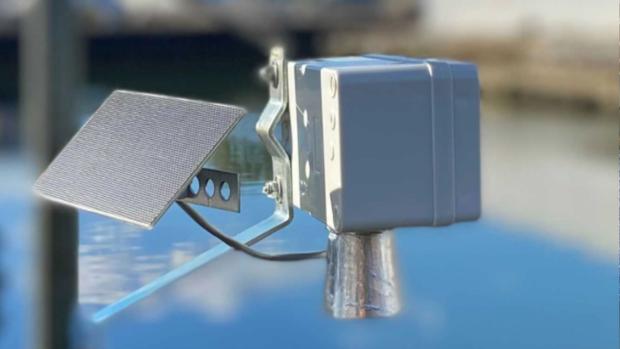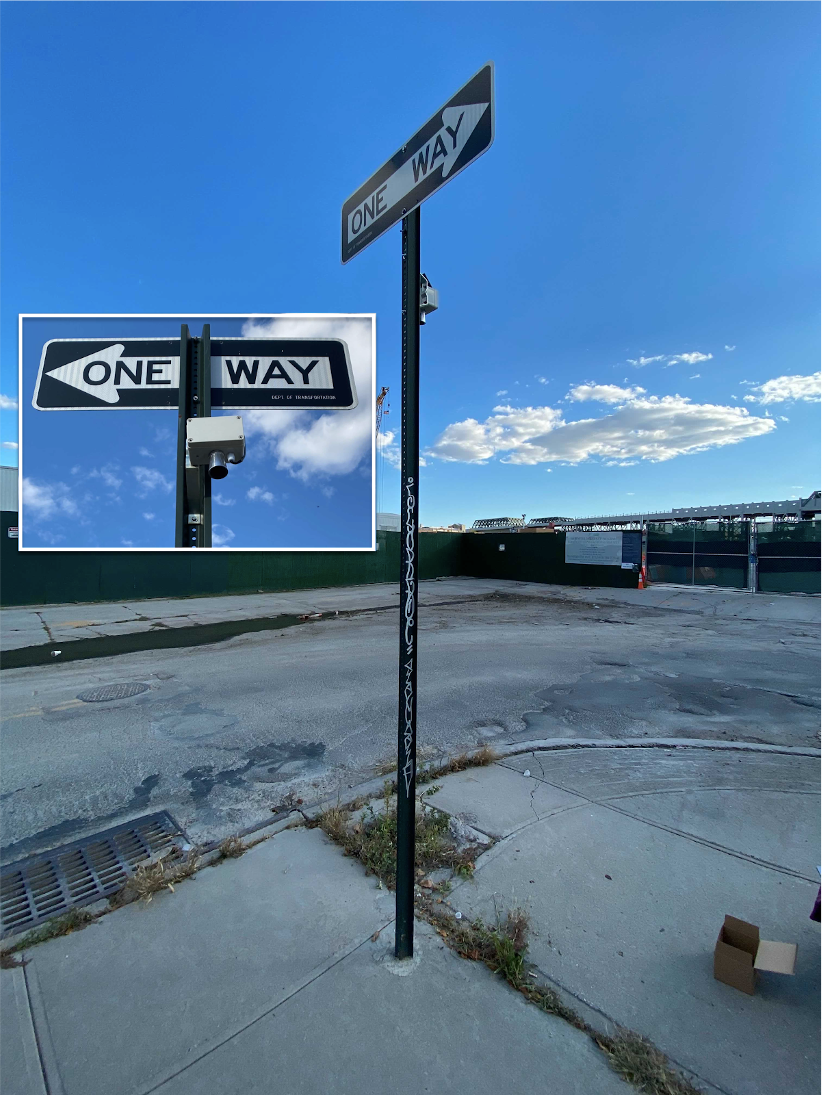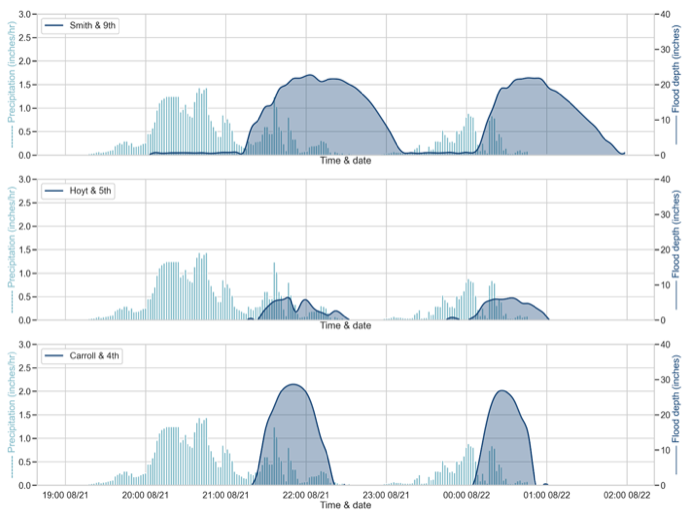FloodNet: Hyperlocal flood sensors to support real-time flood monitoring, flood response, and urban resilience planning in NYC
A public/private consortium including NYU Tandon, researchers at the City University of New York (CUNY) and NYC Mayor’s Office of Climate Resiliency and Mayor’s Office of the Chief Technology Officer plans to expand city-wide a pilot project of flood sensors.

The ultrasonic-based flood sensors being deployed for FloodNet is powered by a small mounted solar panel, and includes within a housing an ultrasonic range sensor, a lithium polymer battery, electronics for solar charge distribution, a LoRa board for long range communications and networking and other electronics.
BROOKLYN, New York, Wednesday, October 6, 2021 — Whether the result of tidal flooding, extreme events like Hurricanes Henri and Ida, or more frequent cloudbursts, flooding affects public health and safety, mobility, infrastructure, and the city’s economy. In the face of climate change, which is likely to increase the frequency and severity of such events, the city needs access to real-time data providing critical information on when and where flooding occurs. However, the city has had limited data available on the frequency, extent, and depth of floods. In particular, there has been no quantitative, systematically-collected data on street-level flooding in NYC outside of reports made to NYC's 311 service request line.
A multi-institutional collaboration, FloodNet, is addressing this challenge through the design, manufacture, and deployment of novel, low-cost, open-source sensors in flood-prone areas across NYC. Involving The City of New York, the NYU Tandon School of Engineering, The City University of New York (CUNY), and community partners in affected neighborhoods, FloodNet aims to provide real-time data on the scope and scale of local flood events to a range of stakeholders, including citizens, policy makers, government agencies, emergency response teams, community advocacy groups, and researchers.
Last week, the city highlighted its support of the FloodNet program, in its first report from the newly created Extreme Weather Response Task Force, highlighting initiatives and strategies for mitigating future extreme precipitation events.
The uses of the FloodNet data include emergency preparedness, resiliency and transportation planning, and validating NYC stormwater flood models and future flood maps. The data will:
- Feed into an early warning system throughout the city, informing road closures or travel bans and alerting drivers to avoid flooded and dangerous streets.
- Alert communities to the need for emergency preparedness and response, including activating real-time mitigation measures like sandbags and removal of valuables from basements.
- Be used to identify areas the most urgently need post-storm assistance
- Validate existing flood models and better hone predictions and flooding thresholds
- Inform long-term storm water resiliency planning
“Our sensor data and platform will aid NYC residents living in flood-vulnerable communities by providing high-quality data that can be used for improved resiliency planning, emergency response, and advocacy,” said Andrea Silverman, professor of environmental engineering, who, along with Professors Elizabeth Hénaff, Charlie Mydlarz, and Tega Brain at NYU, and Brett Branco and Ricardo Toledo-Crow at CUNY, oversee the FloodNet sensor deployments.
Currently in a pilot phase — with three sensors deployed in areas of Gowanus, Brooklyn that are at risk of stormwater flooding, and four sensors deployed in Hamilton Beach, Queens and the Rockaway peninsula, neighborhoods surrounding Jamaica Bay that are prone to coastal flooding — FloodNet delivered valuable, real-time data during recent flood events associated with Henri and Ida.
- The FloodNet sensors recorded flash floods in Gowanus in real-time and with high resolution
- They provided a rich data set including flood depth and profile over time. For example, during Tropical Storm Henri, the sensors recorded two distinct flood events on the same night separated by an hour where the water receded.
- During Ida, the sensors recorded up to 3 feet of flooding in one location, with flood waters rising quickly, peaking within 20 minutes, creating extremely hazardous conditions.
- The FloodNet alert system generates emails and Telegram app messages at the detection of a flood that exceeds 3 inches, and there are early indications that these warnings were received prior to warnings from other city detection systems.
Developed by researchers at NYU Tandon’s Center for Urban Science and Progress (CUSP) and the CUNY Advanced Science Research Center (ASRC), with the support of the C2SMART University Transportation Center at NYU Tandon and the CUNY Office of Research, and in partnership with the NYC Mayor’s Office of Climate Resiliency (MOCR), NYC Mayor’s Office of the Chief Technology Officer (NYC CTO), and the Science and Resilience Institute at Jamaica Bay, the FloodNet sensors can detect flood depths as low as 0.5 inches. Given the hyper-local and distributed nature of urban flooding, the sensors were designed to be affordably built and easy to install, to allow deployment of a large, distributed sensor network. Additionally, the sensors are:
- Flexible for multiple use cases and scenarios (not requiring power or connectivity infrastructure)
- Easy to construct with a simple open-source design (allowing community participation in construction and deployment)
- Accessible via open-source firmware, software, and hardware design files publicly available online at a github repository
The consortium will soon incorporate a realtime dashboard on its online interface at FloodNet.nyc, to integrate, store, and disseminate sensor data and other flood-related data streams (including community-reported flood events, rainfall data, 311 complaints, and related social media posts) to a range of stakeholders, including community members, city agencies, researchers, weather forecasters, and reporters. Development of the data portal is supported by a grant from the New York State Empire State Development Corporation.

“This project is a direct result of frequent and long-term dialogue with communities and city agencies about the tools and resources needed to better respond to the challenges of sea level rise, coastal storms and extreme rainfall events,” said Brett Branco, Director of the Science and Resilience Institute at Jamaica Bay. “Along with other sources of information about flooding, these flood sensors can help guide resilience projects that protect people and infrastructure from future hazards.”
The team plans to deploy additional sensors in other flood-prone neighborhoods in the coming months.

About the New York University Tandon School of Engineering
The NYU Tandon School of Engineering dates to 1854, the founding date for both the New York University School of Civil Engineering and Architecture and the Brooklyn Collegiate and Polytechnic Institute. A January 2014 merger created a comprehensive school of education and research in engineering and applied sciences as part of a global university, with close connections to engineering programs at NYU Abu Dhabi and NYU Shanghai. NYU Tandon is rooted in a vibrant tradition of entrepreneurship, intellectual curiosity, and innovative solutions to humanity’s most pressing global challenges. Research at Tandon focuses on vital intersections between communications/IT, cybersecurity, and data science/AI/robotics systems and tools and critical areas of society that they influence, including emerging media, health, sustainability, and urban living. We believe diversity is integral to excellence, and are creating a vibrant, inclusive, and equitable environment for all of our students, faculty and staff. For more information, visit engineering.nyu.edu.


